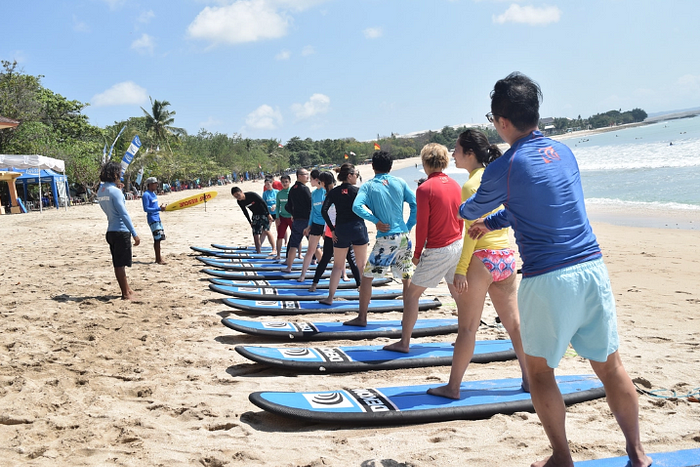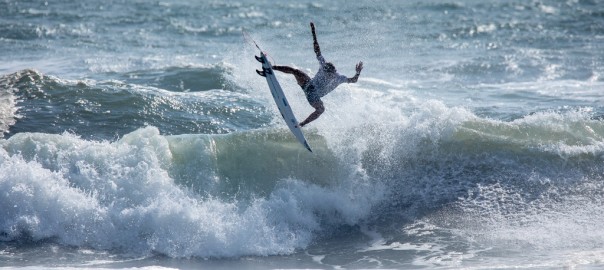I HATE SURFING. i know it’s my fault with not enough preparation before i jump into the experience.
However, my initial attempts were anything but smooth sailing. I vividly remember the frustration of arriving at the beach only to find the waves too fierce or the tide too low.
I endured the sunburns from forgetting sunscreen, the muscle cramps from insufficient warm-ups, and even the embarrassment of using a damaged surfboard.
These unlucky experiences taught me valuable lessons the hard way. To save fellow surf enthusiasts from the pitfalls I faced, I’ve compiled a list of the top 10 things to do before surfing. Follow these tips to ensure your surfing sessions are safe, enjoyable, and unforgettable!
Take Your Note Out!
Prepare yourself before a war.. with ocean wave of course.
1. Check the Weather and Surf Report
- Why It’s Important: Knowing the weather and wave conditions helps you avoid dangerous situations and choose the best time to surf.
- Details: Use reliable sources like Surfline or Magicseaweed to get accurate reports on wave height, wind speed, and tide times. Check these reports the night before and again in the morning before heading out. Understanding these conditions ensures you’re prepared for what the ocean throws your way, increasing your safety and enjoyment.
2. Hydrate and Fuel Up
- Why It’s Important: Staying hydrated and having the right fuel prevents fatigue and keeps your energy levels high during your surf session.
- Details: Drink at least 16 ounces of water an hour before surfing and bring a water bottle with you. Eat a light meal rich in carbohydrates and protein, like a banana with peanut butter or a smoothie with oats, an hour or two before you head out. Avoid heavy, greasy foods that can weigh you down and make you feel sluggish.
3. Stretch and Warm-Up
- Why It’s Important: Stretching and warming up increases your flexibility and blood flow, reducing the risk of injury.
- Details: Spend 10–15 minutes on dynamic stretches like leg swings, arm circles, and torso twists. Follow this with a few minutes of light cardio, such as jogging along the beach. Focus on areas like your shoulders, back, hips, and legs, which are heavily used in surfing. This routine prepares your muscles and joints for the physical demands of paddling and riding waves.
4. Inspect Your Gear
- Why It’s Important: Ensuring your equipment is in good condition prevents unexpected failures in the water.
- Details: Check your surfboard for dings or cracks that could let water in and affect performance. Ensure your leash is securely attached and not frayed. Apply a fresh coat of wax to your board for better grip, especially in critical areas like the deck where your feet will be. A thorough inspection helps you avoid equipment malfunctions that could cut your session short or put you in danger.
5. Apply Sunscreen
- Why It’s Important: Protecting your skin from UV rays prevents sunburn and long-term skin damage.
- Details: Use a broad-spectrum, water-resistant sunscreen with at least SPF 30. Apply it generously 15–30 minutes before going out, covering all exposed areas, including often-missed spots like the back of your neck, ears, and the tops of your feet. Reapply every two hours, especially after being in the water. Wearing a rash guard with UV protection can provide additional coverage.
6. Plan Your Entry and Exit Points
- Why It’s Important: Knowing the safest points to enter and exit the water helps you avoid hazards and conserve energy.
- Details: Take a few minutes to observe the surf spot and identify areas with fewer rocks, strong currents, or other obstacles. Choose entry and exit points that allow for easy access to and from the waves. This knowledge helps you avoid getting caught in rip currents or crashing into rocks, making your session safer and more enjoyable.
7. Watch the Waves
- Why It’s Important: Observing the waves helps you understand the conditions and choose the best waves to catch.
- Details: Spend 5–10 minutes watching the sets to understand the timing and pattern of the waves. Look for consistent peaks and note the intervals between sets. This observation helps you position yourself better in the water, increasing your chances of catching quality waves and having a smoother ride.
8. Check Your Fitness Level
- Why It’s Important: Being physically prepared ensures you have the stamina and strength to handle the demands of surfing.
- Details: Assess your fitness by doing a quick warm-up and a few paddling exercises on land. If you feel any unusual pain or fatigue, it might be a sign to take it easy or adjust your session. Regular strength and cardio training, focusing on core, upper body, and leg strength, can improve your surfing performance and endurance.
9. Communicate with Fellow Surfers
- Why It’s Important: Sharing information with other surfers can provide valuable insights and enhance safety.
- Details: Talk to surfers coming out of the water to get a sense of the current conditions and any hazards to watch out for. Join local surf groups or online forums to stay updated on surf spot conditions and events. This communication fosters a sense of community and can provide tips that improve your surfing experience.
10. Set Goals and Mindset
- Why It’s Important: Having clear goals and a positive mindset helps you focus and improve your skills.
- Details: Before you hit the water, set specific, achievable goals, such as catching a certain number of waves or practicing a particular maneuver. Visualize your success and approach the session with a positive attitude, ready to embrace challenges and learn from them. This mindset keeps you motivated and enhances your overall surfing experience.
You may also like : Top 1 Surfing Camp in Bali
Top 10 What Happend When You Don’t Listen in Me

Fine.. i know you won’t listen when something doesn’t actually happend (mad). Here is Top 10 What Happend when you don’t.
1. Encountering Dangerous Weather and Wave Conditions
Without checking the weather and surf report, you might find yourself facing waves that are too big or currents that are too strong. This can lead to dangerous situations, making it difficult to return to shore and increasing the risk of drowning.
2. Dehydration and Lack of Energy
Failing to hydrate and fuel up before hitting the waves can lead to dehydration and a lack of energy. Surfing is physically demanding, and without proper nutrition, you can quickly become exhausted, which impairs your ability to perform and stay safe in the water.
3. Increased Risk of Injuries
Skipping your warm-up routine can leave your muscles stiff and more prone to injuries. Dynamic stretches and exercises prepare your body for the rigorous activity of surfing, reducing the risk of cramps, strains, and sprains.
4. Equipment Failures
Not inspecting your gear can lead to unexpected failures in the water. A damaged surfboard, a broken leash, or insufficient wax can all result in lost waves, frustrating experiences, and potential safety hazards.
5. Severe Sunburns
Without applying sunscreen, you expose your skin to harmful UV rays. Severe sunburns can ruin your day and have long-term health consequences, including an increased risk of skin cancer.
6. Navigational Challenges
Neglecting to plan your entry and exit points can lead to navigational challenges and unsafe situations. Unfamiliarity with the surf spot might make it difficult to avoid hazards like rocks or strong currents, putting you at risk of injury.
7. Misjudging Wave Patterns
Not taking the time to watch the waves can result in missed opportunities and poor wave selection. Observing wave patterns helps you understand the rhythm and choose the best waves to ride, enhancing your surfing experience.
8. Physical Unpreparedness
If you’re not in good physical condition, surfing can quickly become overwhelming. A lack of fitness can lead to exhaustion, putting you at risk of accidents and reducing your overall enjoyment of the sport.
9. Missed Insights from Fellow Surfers
Failing to communicate with fellow surfers means missing out on valuable insights about current conditions and potential hazards. Fellow surfers can provide tips and warnings that can enhance your safety and enjoyment.
10. Lack of Focus and Purpose
Going into a surf session without clear goals or a positive mindset can lead to frustration and a lack of progress. Setting realistic goals and maintaining a focused mindset are key to improving your skills and having a fulfilling surfing experience.
You may also like : Most Affordable Surf Course






